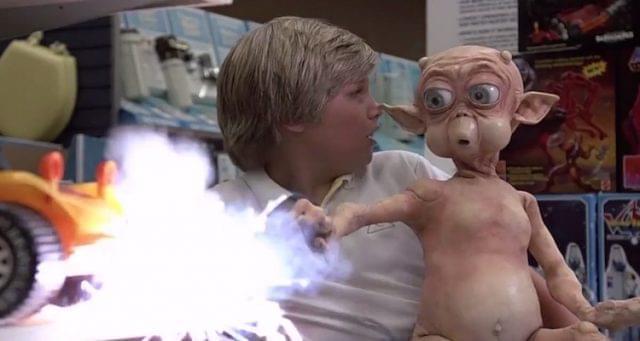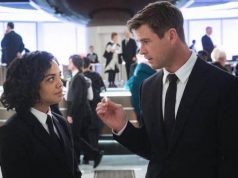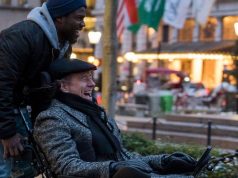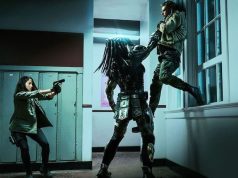
Hollywood has had an impact on consumer trends ever since the early days of film. Our history books speak of Charlie Chaplin’s “Little Tramp” character being so popular that it inspired millions of people to forsake their jobs and homes and live on the streets in the early 1930s. (The Great Depression also occurred during this time.) In the 1950s, when Cary Grant and Jimmy Stewart were wearing their pants so high that their belts chafed their nipples, all of America followed along. It wasn’t until the early 1970s that men’s trousers re-descended to their proper elevation.
But when Hollywood tries to force a trend by inserting blatant product placement into its films, the results are often mixed. For every “E.T.,” which famously helped the popularity of Reese’s Pieces by making them the title character’s favorite candy, you have a dozen cases like “One Flew over the Cuckoo’s Nest,” which did nothing to increase sales of electro-shock-therapy equipment.
Thus we come to “Mac and Me,” which employs some of the most egregious and outlandish product placement in history. Like all good Americans, I occasionally enjoy a meal at McDonald’s, a drink from the Coca-Cola company, or a handful of Skittles-brand chewy candies — but seeing these products pimped with such enthusiasm and vigor in “Mac and Me” is a turn-off. It makes me want to go to Burger King, order a Pepsi, and eat whatever the generic equivalent of Skittles is. (Little candy-coated globs of toothpaste, maybe?)
What’s alarming is that it’s a terrible movie anyway, a boring, bald-faced rip-off of “E.T.” that’s half-over before the Elliot character even officially meets the E.T. character. There are numerous continuity errors, plot holes, and embarrassing special effects, suggesting that when the people at McDonald’s co-sponsored the production (really!), they had the same attitude they have toward their food, i.e., that it doesn’t matter if it’s good, it just needs to say “McDonald’s” on it.
We begin on a distant, rocky planet that resembles Arizona, except that unlike Arizona, this planet can sustain life. A family of alien creatures who resemble skinny actors wearing tight-fitting alien costumes is out foraging for food when a NASA space probe lands, gathers them up, and heads back to Earth. At NASA headquarters, which are apparently in California now, the Mama, Papa, and Junior aliens make a run for it, while Baby alien gets separated from them and strikes out on his own.
The li’l fella looks just like his parents and sibling, with huge eyes and an O-shaped mouth that makes him look like a constantly surprised Jimmy Stewart (whose surprise no doubt stems from how much his belt has chafed his nipples), and fat, jowly cheeks that make him look like Walter Matthau. He and his fellow aliens do not walk the line between “cute” and “ugly” so much as they shuffle up to the line and frighten it away with their ugliness. They are hideous monsters, and you would not seek to befriend one if it appeared in your house. You would scream in terror, void your bladder, and summon a priest.
The human hero of the story does none of these things. He is 12-year-old Eric Cruise, and he is confined to a wheelchair for unspecified reasons. (The actor who plays him, Jade Calegory, is actually disabled in real life, having been born with spina bifida. I don’t have a joke about this, I just thought it was interesting.) (OK, I do have jokes about it, but they’re in poor taste.) Eric and his mother, Janet (Christine Ebersole), and older brother, Michael (Jonathan Ward), are driving from Chicago to their new home in Southern California when they come upon a pileup caused by the baby alien scampering across the road. In the confusion, the alien sneaks into the family’s van and goes home with them.
The alien stays out of sight, instinctively aware that if humans capture him, they’ll do to him what they do to all freaks: give him his own reality show. But while staying hidden in the Cruise home, he also perpetrates bizarre acts of mischief, like magically filling the living room with desert flora while the family sleeps. The next morning, Janet and Michael accuse Eric of doing it, apparently forgetting that he’s in a &@*# wheelchair. Yeah, morons, he can’t walk, but he can crawl around all night planting bushes in the living room for a practical joke.
Eric catches glimpses of the alien, but no one believes him. Saddened by all this, he wheels himself into the backyard, all the way to the far edge of the grass, where the yard suddenly stops and there’s a steep slope plunging a few hundred feet into a lake. Eric and his wheelchair fall down this slope and Eric nearly drowns. Luckily, he is saved by the alien, whose existence his mother and brother still do not believe in. Perhaps he should tell Child Protective Services about it when they come to ask why Janet Cruise bought a house with a deadly cliff in the backyard and no fence to prevent her wheelchair-bound son from rolling over it.
Eventually Eric and Michael and the neighbor girls, who are annoying and will remain unnamed here, meet the alien for real and name him MAC, as in Mysterious Alien Creature. (MAC might also make you think of “Big Mac,” as in the signature item at McDonald’s, but surely that is coincidental.) They discover that MAC likes to drink Coca-Cola, which is made convenient by the many open cans of Coca-Cola that are placed strategically around the house, some with straws already in them. Does MAC like flat, warm Coke? Apparently! Which I guess means RC Cola would be OK, too.
Then they have to go to a birthday party being held at McDonald’s (obviously), and the neighbor girls’ mother is driving them, but they can’t leave MAC behind because they know that NASA has sent federal agents looking for him. (Oh, I forgot — NASA sent federal agents looking for MAC. They tracked him to the Cruise house, don’t ask me how.) The only viable solution is to dress MAC up in a teddy bear costume and tell the neighbor mom that he’s Eric’s teddy bear. When the neighbor mom points out, reasonably, that this alleged “teddy bear” is moving, Eric says it’s one of those fancy computerized teddy bears. This explanation satisfies neighbor mom, who is evidently as stupid as Eric’s own mom.
(Discussion question: Why does Eric have a junior-size teddy bear costume lying around?)
At McDonald’s, things are hoppin’, my friends. The place is packed with kids, and soon an elaborately choreographed “dance contest” breaks out involving everyone in the store except for those in wheelchairs. (Sorry, Eric!) Among the dancers are three football players in full game-day regalia; their presence and attire are not explained. MAC, in his teddy bear costume that magically makes him appear about a foot taller, as though the occupant of the teddy bear costume were not MAC at all but an 8-year-old child, jumps up on the counter and leads the dancing. He is not very good at it, but I guess an animatronic teddy bear breakin’ it down in a fast-food restaurant is like what Samuel Johnson said about a dog walking on its hind legs: It is not done well, but you are surprised to find it done at all.
Somehow, Eric and Michael and the neighbor girls and MAC wind up fleeing from the feds and driving into the desert, where MAC leads them to his family members, who are hiding in an old mine shaft. (MAC knew they were there via telepathy.) They are ailing, but a little Coca-Cola picks ’em right up again, good as new. Then the whole group somehow winds up in a grocery store, where the shoppers are alarmed by the alien family, especially the alien father, who struts around with his groin thrust forward, Mick Jagger-style, in what I assume was the actor’s best guess at what an alien walk would look like. Then somehow there is a misunderstanding with the security guard, and there’s a gun, and then the alien dad blows up the store in self-defense (note: the aliens can blow things up), and Eric is killed.
It’s not clear what actually killed Eric, since he’s lying there in the parking lot with no visible injuries. Just the sheer surprise of the aliens blowing the place up? Maybe. I was pretty surprised myself. At any rate, the aliens use their dark magic to resurrect Eric, though he’s still confined to a wheelchair. Seems to me if you can raise the dead you ought to be able to make the lame walk and the blind see, too, but what do I know?
The point is, they all live happily ever after — including the aliens, who in the final scene are sworn in as American citizens, and I am NOT MAKING THAT UP. That’s really how the movie ends. There’s a hint of a sequel, but the film’s financial failure put the kibosh on that. Too bad, because a sequel to “Mac and Me” would obviously be called “The Burger King and I,” and that’s a great title.
— Film.com





